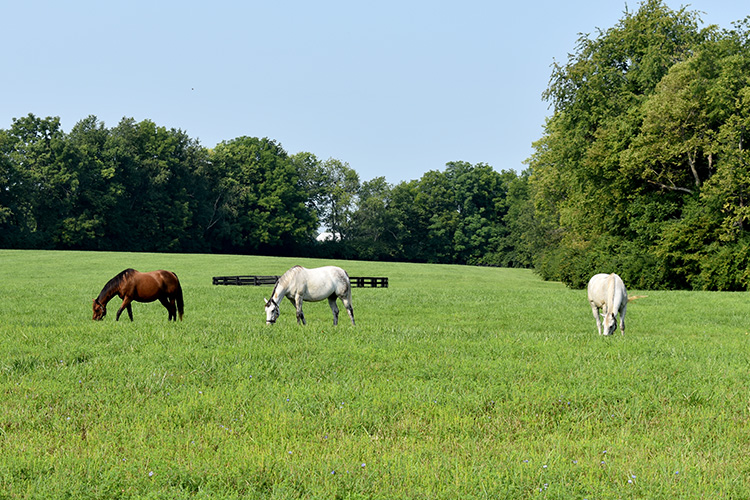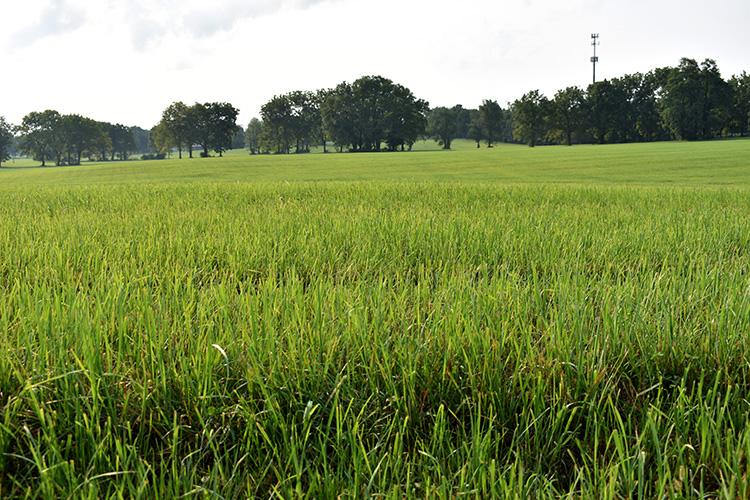Pasture renovations will help horse farm implement rotational grazing
Pasture renovations will help horse farm implement rotational grazing

To view the video, click here.
Spendthrift Farm is one of Lexington’s iconic Thoroughbred breeding and racing operations. Due to recent expansion, the farm wanted to renovate some unused fields and develop them into pastures to use in a rotational grazing system. They turned to forage experts with the Horse Pasture Evaluation Program in the University of Kentucky College of Agriculture, Food and Environment for their recommendations.
“The Horse Pasture Evaluation Program is a good tool for all horse farms to use,” said Robbie Moreland, Spendthrift maintenance manager. “It gives us options and guidelines that we can use to develop the land to suit our needs.”
Spendthrift Farm has worked with Krista Lea, UK research analyst, and Ray Smith, UK forage extension specialist, for a number of years to evaluate and renovate fields on their main farm through the program.
“They have done a good job of implementing grazing rotations, as well as removing fescue from some key broodmare fields and having good success with over seeding,” Lea said. “This was our first endeavor with them trying to completely re-establish a pasture.”

Thick, lush grasses grow on the renovated pasture at Spendthrift Farm. Photo by Katie Pratt, UK agricultural communications.
The pasture renovation that began in summer 2019 includes 130 acres of an adjoining property the farm purchased a few years back but had not fully incorporated into their operation.
“The land was physically rough, and the grass was consumed by weeds. We decided the best thing to do was just to start completely over again and develop a grass pasture,” Moreland said.
Farm management wanted to establish pastures that were healthy and beneficial for their horses and good for the natural environment. In 2019, they opted to kill off the existing vegetation using tillage, rather than a traditional field burndown with glyphosate. They reseeded the fields with a mixture of bluegrass, orchardgrass and perennial ryegrass. Even though Central Kentucky experienced a drought last fall, the seed germinated and created a lush stand of grass.
Moreland said Spendthrift plans to start fencing the renovated pasture and building a barn this fall, with the goal of allowing horses to graze in the pasture in the spring. Moreland said it was important to the farm to slowly and methodically prepare the ground for grazing.
“We would like to keep these pastures lush,” Moreland said. “To do this, we are going to use it as a pasture rotation with our main farm. The new pastures and barn will be used for our mares and weanlings.”
Spendthrift Farm is just one of the farms the Horse Pasture Evaluation Program advises each year. From its beginnings in 2005 to 2019, the program conducted more than 250 evaluations on horse farms of all sizes and breeds. In 2020, Lea and her student interns have evaluated nearly 30 farms. This is the highest number of operations they have serviced in any one year.
“A high-quality pasture is beneficial to both horses and the environment,” Lea said. “It allows horses to select the best possible forage and stay away from undesirable weeds. We know that good quality pasture maintains a lot of cover, and that reduces soil erosion, prevents nutrients from leaching off that pasture and maintains the soil that is there.”
More information about the program is available at https://forages.ca.uky.edu/pasture_eval.
Ag Equine Programs Extension



